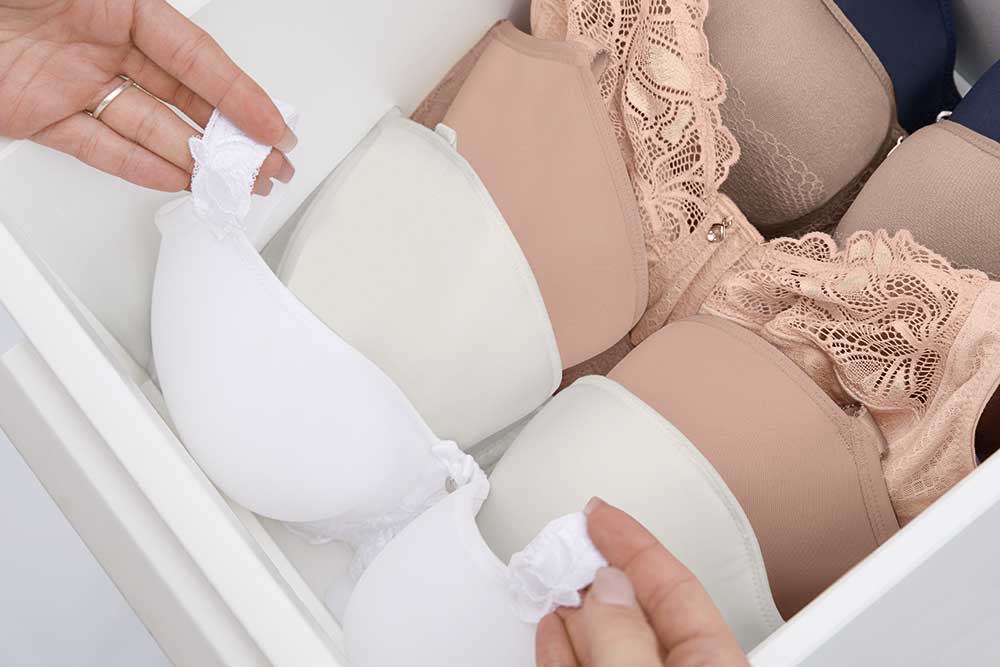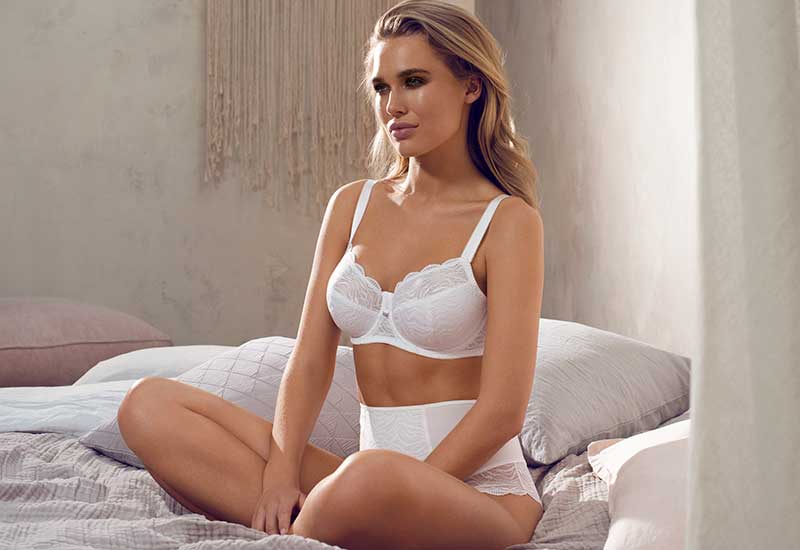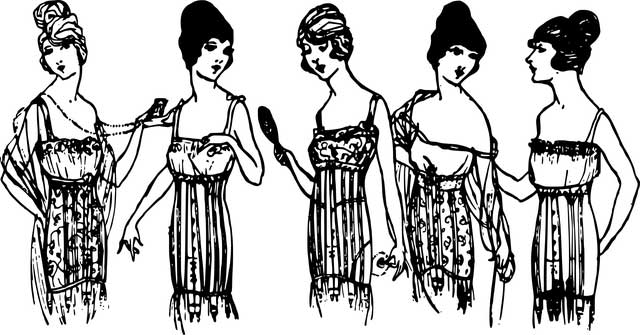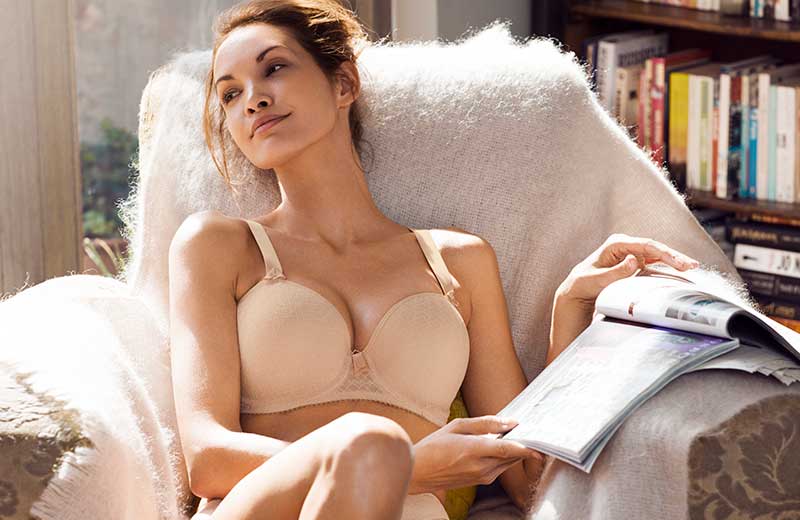
The evolution of the bra and bra fitting has grown over the centuries, from design to design, to where we are now. Bra styles have been influenced by the fashion and culture industry for hundreds of years, from corsets and bandeau bras to sports bras and triangle bras and it will never stop evolving. Bras have gone from being an essential item to somewhat of a fashion statement, where you can now wear longline bras and bralettes as outerwear instead of just underwear. Women have moved from firm, corseted bras to comfortable lightweight styles, that both look and feel good without the need to suffocate themselves!
Why do women wear bras?
Good question...and a fairly simple answer - to support our breasts. Bras help the muscles and the spine get into a better position, as well as giving women a more uplifting silhouette and waistline. Bras can be seen as both functional and feminine to wear.
Women do not need to wear a bra on a daily basis, but it's extremely important to wear one when doing any exercise and sports activity. The breasts move a lot and a sports bra protects them, relieves back pain and provides comfort for you.
Some women would argue that bras are very uncomfortable, but if you get the correct bra fitting and bra size, a bra will provide comfort and support to your breasts without digging in or feeling uncomfortable.
A bra is almost seen as a right of passage for young women when they grow up.

Impression Underwired Bra | Fantasie
Who invented the bra and bra sizes?
It's said that the first bras may date back to ancient Greece, where women would wrap fabric around their chests and tie or pin it back to secure their breasts in place.
But the first sighting of underwear was in the 16th century, with the arrival of the corset. This was the primary piece of underwear used from the 16th to the 19th century to give women the 'perfect' inverted cone shape and lift, push and separate the breasts. These corsets were designed to fit the individual wearer and made with wood, horn, whalebone, metal or ivory with heavy lacing at the back. The corset shape has changed dramatically and has experienced periodic revivals over the years, with fashion movements such as Moulin Rouge and fashion designer, Vivienne Westwood. They are now considered very much bedroom and outwear attire as opposed to underwear.
 In 1893, a lady called Mary Tucek patented the first undergarment simile to a modern-day bra called a 'Breast Supporter'. This featured separate pockets for each breast, straps that went around the shoulders and hook and eye closure. This was not a well known invention as it was never marketed successfully and therefore hardly ever mentioned.
In 1893, a lady called Mary Tucek patented the first undergarment simile to a modern-day bra called a 'Breast Supporter'. This featured separate pockets for each breast, straps that went around the shoulders and hook and eye closure. This was not a well known invention as it was never marketed successfully and therefore hardly ever mentioned.
In 1907, the term 'brasserie' came up in high profile women's magazines and eventually appeared in the Oxford English Dictionary around 1912.
In 1913, New York socialite, Mary Phelps Jacob invented and patented the first 'modern bra' using two silk handkerchiefs and ribbon called the "Backless Brassiere". It was soft, lightweight and naturally separated the breasts. She later sold the patent to Warner Brothers Corset Company for $1,500.
The 1920's gave way to the bandeau bra where they wore tight bandeau tops that flattened the breasts and gave them more of a 'boyish' body shape.

The 1930's were when bra cup sizes were invented and when brassieres became known as 'bras'. A company called Formfit created the sizes 'small, 'medium' and 'full size' bras. But then the A-D bra system was created, either by William and Ida Rosenthal of Maidenform or by S.H Camp and Company where the letters correlated to the breast sizes. This offered bet fit and shape. There was also the innovations of underwires, adjustable straps and hook & eye closures.
The first padded bra was released by Frederick Mellinger, from the famous brand Frederick's of Hollywood in the 1940's, which changed the face of the fashion and lingerie industry completely and was considered 'sexy'.
The birth of the bullet bra started in the 1950's, where new fabrics, colours and patterns were being used to manufacture bras. This decade is where Hollywood stars like Madonna and Marilyn Monroe was seen wearing bullet bras and popularised them throughout the lingerie world.

The first ever 'Wonderbra' was created in 1964 by Canadian designer, Louise Poirier from the company Canadelle. It featured 54 separate elements and was designed to alter the shape and direction of the cleavage. It didn't begin to gain worldwide presence until the 1990's.
As health and fitness became extremely popular, it wasn't until 1977 that the first general sports bra was invented by Lisa Lindahl, Polly Smith and Hinda Miller and called a 'jockbra'. This is because its first design was simply made from two jockstraps sewn together. They were tired of being uncomfortable whilst exercising and as you know bouncing boobs hurt!
The sporty, leggy look was embraced in the 1980's with lots of bustiers, softer bras and experimentation with fashion in general.
In the 1990's, the push-up bra skyrocketed into popularity with the Wonderbra finally having it's moment in the spotlight.
The first 'Million Dollar Miracle Bra' was launched by Claudia Schiffer and Victoria's Secret in 1996 and bedazzling bras became a fashion craze, with the most expensive piece of lingerie worth $20 million.
2009 seen the first use of memory foam in bras, where comfort and sexiness can now coexist. To this day, there are over 10 different bra styles and even more lingerie styles that each have unique features and uses.

Bra Fitting History
With the first A-D bra size system launching in the 1930's, women started to get a little confused on what size they should wear. The letters actually only referred to the approximate degree of the bust size, so if you had a very small bust, you would choose an A and so on.
The numbers for bra sizes were finally introduced after World War 2, but it did not refer to the actual measurement of the back size, like it does now, it referred to a full bust. i.e if you measured 34 over the fullest part of your bust and looked like you had small sized breasts, you would be a 34A.
In the 1970's, bra sizing became more standardised, where the European Common Market put in place new regulations that the 'number' of the bra size would refer to the under bust measurement instead of the full bust measurement. Unfortunately, this new bra system came with a fair bit if criticism.
From here the current way of measuring bra sizes came into play, where the bra size was calculated from the difference between the under bust measurement and the full bust measurement. But once again, women were horrified at this technique, especially if they didn't fit into any existing bra size that was available to them. At first lingerie manufacturers did not change their bra size range to keep up with this change, but instead began telling women to add 4" or 5" to the under bust measurement. Women ended up buying similar bra sizes to what they had always worn and this was known as 'vanity sizing'.
To this day, we still use the 4" and 5" calculation for bra measuring, but there is quite a bit of contradiction on this, as women are acknowledging the wide variety of bra sizes that lingerie manufacturers actually now offer, starting from 28A - 48J. Have you had your bra size measured and if you did, what technique was used on you?

We have some great pages in our Fitting Locker that may guide you more on bra sizes and bra fitting. You can find the links below.
How Should a Bra Fit?
How to Measure your Bra Size at Home?
How to Put a Bra on?